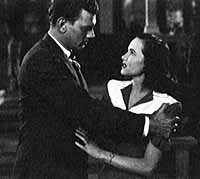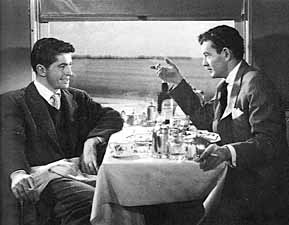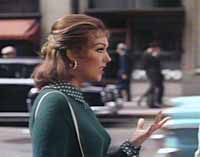20
Like Nabokov, Hitchcock fascination with Poe is reflected in his work.
While Poe was a general influence on Hitchcock, the maker of "scary"
movies, there appears to be several very specific and direct allusions
to Poe in Marnie. As opposed to Winston Graham's novel, Marnie's last
name in the film is changed to "Edgar." The film takes place in New
York (Strutt's office), Virginia (Garrod's Stables) and Philadelphia
(Rutland Publishing and Wickwind). These are the three places that Poe
lived throughout the better part of his life. Finally, and most
conclusively, the film's climactic scene takes place at Marnie's
mother's home in Baltimore, the city where Poe died under mysterious
circumstances in 1849. Hitchcock's allusions to Poe in Marnie are not
surprising since the film is probably Hitchcock's most ambitious effort
to detail the subjective inner states of his problematic central
character through the use of cinematic technique (like the red flashes),
just as Poe devoted himself to writing stories in which his characters
are subject to psychological terror.
Conclusion
The intent of this article is not to suggest that there was any direct
connection or even any overt influence between Alfred Hitchcock and
Vladimir Nabokov. Nabokov is on record as having seen at least one
Hitchcock film and probably saw several others (I'd be surprised if he
did not see Strangers on a Train) and Hitchcock, in asking Nabokov to
collaborate with him, must have had a least a passing familiarity with
Nabokov's work (again, I'd be surprised if he had not read Lolita). My
intent here, however, is merely to suggest that there was a strong
affinity between the work of these two men, an affinity based on their
artistic personalities that has not, by and large, been acknowledged.
While I have tried to point out some areas of confluence in their works,
I feel the primary affinity is in the similar relationship that
Hitchcock and Nabokov established with their audience/readers; a
relationship of playfulness, obtuseness, self-allusiveness and parody.
Both men were masters of their respective mediums; Nabokov, a brilliant
user of words, and Hitchcock a manipulator of cinematic imagery. As a
result, both men attempted (usually successfully) to control the
aesthetic game that they played with their respective audiences.
In 1972 Hitchcock released Frenzy, his second to last film and Nabokov
published Transparent Things, his last novel. Alfred Hitchcock and
Vladimir Nabokov did not ever collaborate. One can only imagine the
kind of involuted, complex, and playful work these two men would have
produced; unfortunately, we can only speculate about what might have
been. Still, we can acknowledge that the works of Vladimir Nabokov and
Alfred Hitchcock share much in common, just as these two men's lives
shared many common circumstances. What is left, in the end, is the work
they produced, which can be well summarized by a line the fictional John
Shade wrote in "Pale Fire": "Life is a message scribbled in the dark."21


 In Shadow of a Doubt,
Hitchcock's first American masterpiece, he uses the doppelganger theme
straightforwardly to contrast the "evil" Uncle Charlie with his "good"
niece, young Charlie, who must reach within her own heart of darkness to
kill her uncle at the film's end. Hitchcock seemed to be having more
fun with the motif in Strangers on a Train (see above for a discussion
of the film's cameo), utilizing a memorable performance by Robert
Walker's flamboyant Bruno to contrast Farley Granger's "normal" Guy.
In Shadow of a Doubt,
Hitchcock's first American masterpiece, he uses the doppelganger theme
straightforwardly to contrast the "evil" Uncle Charlie with his "good"
niece, young Charlie, who must reach within her own heart of darkness to
kill her uncle at the film's end. Hitchcock seemed to be having more
fun with the motif in Strangers on a Train (see above for a discussion
of the film's cameo), utilizing a memorable performance by Robert
Walker's flamboyant Bruno to contrast Farley Granger's "normal" Guy.


 The camera in Hitchcock's films is often
co-opted by the subjective vision of his characters, and he frequently
gives us instances when this vision is "unreliable." Vertigo (1958)
offers several good examples of this, particularly when Scottie thinks
he sees the supposedly dead Madeleine outside her apartment and at
Ernie's Restaurant. And Scotty's vision is totally unreliable after he
convinces Judy to change back into Madeleine; as she comes out of the
bathroom in her clothes and makeup, she appears to emerge from a haze of
green fog. Finally, as they embrace, the room around Scotty becomes the
mission stable where he last embraced his lost love. As mentioned
above, Hitchcock also used an unreliable narrative technique playfully
in Psycho, when his camerawork and use of voice over convinces us that
Mrs. Bates is actually alive.
The camera in Hitchcock's films is often
co-opted by the subjective vision of his characters, and he frequently
gives us instances when this vision is "unreliable." Vertigo (1958)
offers several good examples of this, particularly when Scottie thinks
he sees the supposedly dead Madeleine outside her apartment and at
Ernie's Restaurant. And Scotty's vision is totally unreliable after he
convinces Judy to change back into Madeleine; as she comes out of the
bathroom in her clothes and makeup, she appears to emerge from a haze of
green fog. Finally, as they embrace, the room around Scotty becomes the
mission stable where he last embraced his lost love. As mentioned
above, Hitchcock also used an unreliable narrative technique playfully
in Psycho, when his camerawork and use of voice over convinces us that
Mrs. Bates is actually alive.
 View an animated GIF of Judy's transformation into Madeleine in Vertigo.
View an animated GIF of Judy's transformation into Madeleine in Vertigo.